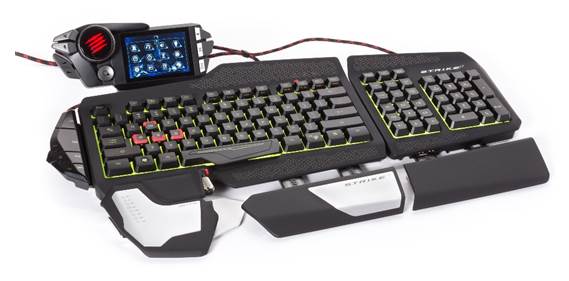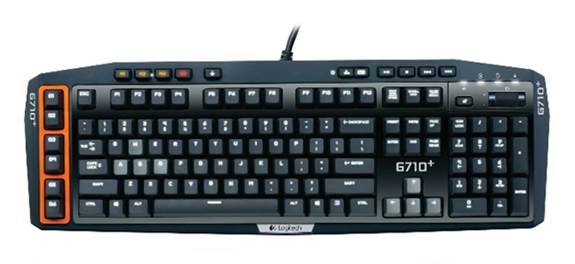We put six high-end key board to the
test, in search of the perfect plank.
If you're a gamer, you can probably
identify a few points in time when you realized something important about your
control setup that made you better at the game. When you discovered that
putting your left hand on WASD gives you more options than putting it on the arrow
keys, for instance, or when you realized that your crappy optical mouse was
actually holding you back in shooters. These kinds of peripheral epiphanies
don't happen every day, but it might be just about time for you to have a new
one. It might be time for you to realize that your keyboard is holding you
back.

If
you're a gamer, you can probably identify a few points in time when you
realized something important about your control setup that made you better at
the game.
We’re giving you some credit here - we’re
not talking about making the upgrade from a $6 keyboard you got at the grocery
store. No, we're talking about making the upgrade from a gaming keyboard to an
amazing gaming keyboard. Going from entry level or midrange to top ofthe-line.
We looked around and picked out six of the
highest-end keyboards released in the last year, starting at just under $100.
To compare them, we put them through our usual battery of real-world testing,
including gaming and typing, and compared their features and overall feel.
Because these keyboards come attached to some pretty heavy price tags, we made
sure to give them extra scrutiny. We know that minor inconveniences that might
fly on a cheap keyboard become a tot more galling when you've paid $150 for the
privilege of suffering them, and our verdicts reflect this.
Ready to make the upgrade to serious typing
hardware? Then let’s go!
The Art Of Cherry picking
If you’re the pattern-recognizing sort, you
may notice that every mechanical keyboard in this roundup uses Cherry MX
switches for their key mechanisms. That's because virtually all mechanical
gaming keyboards today use some variety of Cherry MX switch, such as Brown or
Blue. The names indicate both the actual color of the switch (pry a keycap up
and you'll be able to tell by sight which switch is underneath), and the
switch's mechanical characteristics, in terms of tactility and resistance.
A switch that is highly tactile has a
noticeable "bump” that you overcome as you press it down, and tends to
make a click noise as it passes that bump. A switch with high resistance
requires more force to depress. Here are the four most common varieties of
Cherry MX switch:
Red: A non-tactile switch with low
resistance, The pressing action is smooth, with no bump, and because of its low
resistance it is very responsive. Good for action gamers.
Black: A non-tactile switch, like the Red,
with higher resistance.
Image courtesy of Corsair.
Blue: A highly tactile switch, with a
dramatic (and loud) click. Considered the best switch for typing, but they can
be slightly harder to double-tap quickly for gaming.
Brown: A middle ground switch, with a light
tactile click and medium resistance, Functions well for both typing and gaming.
Razer Death-Stalker Ultimate
Fun to look at, less fun to use
Price: $250
Website: www.razerzone.com
THE RAZER DEATHSTALKER is really a thing to
behold. The gaming keyboard is thin, sleek, and nicely designed with tri-color
glowing keys, but nothing draws your attention like the "Switchblade"
user interface, borrowed from the Razer Blade gaming laptop.
The Switchblade Ul consists of a responsive
multi-touch 4.3-inch LCD touchscreen and 10 context-sensitive dynamic keys. The
screen can act as a track-pad, or can play host to a number of applications
including a web browser, Twitter client, YouTube viewer, and plenty of others,
such as game-specific apps for a handful of popular titles. Additionally, the
keyboard has plenty of on-the-fly macro keys, and the software suite that
manages it is polished and very powerful. In other words, the Razer Death Stalker
is clearly the most sophisticated gaming keyboard around. The question is, do
the Death stalker's technical flourishes justify its massive $250 price tag.

Instead
of a number pad, the Death stalker Ultimate features a touchscreen, along with
10 contextual keys.
At that kind of price, we expect every
element of a keyboard to be top-notch; unfortunately, that's not the case with
the Razer Death stalker. The problem is the keyboard itself, which uses widely
spaced Chiclet-style keys, familiar to anyone who' s used a MacBook or most
Ultrabooks. They look nice, but it's not clear why a large, high-end gaming
keyboard would opt to use them over mechanical switches or even rubber-dome
membrane keys. The Chiclet keys simply don't feel very good to use - they float
around inside their tracks and have miniscule travel when pressed. They're not
awful, but we'd expect a lot better from a $250 keyboard.
Cyborg S.T.R.I.K.E. 7
Plenty of novel features, but look at
that price
Price: $300
Website: www.cyborggaming.com
PROBABLY THE most interesting thing about
the S.T.R.I.K.E. 7 is that it's modular and customizable. When you first take
it out of the box, the keyboard is in seven pieces, which can be screwed
together in a number of different configurations. One of the pieces is a large
touchscreen, which can be affixed to either the left or right side of the
keyboard, as can an extra bank of macro keys and the adjustable "active
palm rest.” which features a thumbwheel and button. The two halves of the
keyboard can be used separately, though both must be connected to the
touchscreen, and the kit comes with a set of 16 replacement key caps, so you
can make sure your S.T.R.I.K.E. 7 doesn’t look like anyone else's.

CYBORG
S.T.R.I.K.E. 7
On the other hand, you probably won't meet
anyone else with a S.T.R.I.K.E. 7, unless you regularly attend LAN parties down
at the yacht club. At $300, this is the most expensive keyboard we can remember
reviewing, and some of the features just don't rise to the level of
expectations set by the price. The touchscreen, for instance, is resistive and
not nearly as responsive as the screen on the Razer Death stalker Ultimate. And
like the Death stalker, the S.T.R.I.K.E. opts for non-mechanical keys.
Though the dome-style membrane keys are
better than the Death stalker's Chiclet keys, we firmly believe that a keyboard
that costs three times as much as most of its competition ought to have the
best keys available.
Logitech G710+
Logitech brings it back to basics
LOGITECH HAS finally decided that the
recent trend toward mechanical gaming keyboards isn't a passing fad, and has
thrown its own hat into the ring with the G710+. At $150, the G710+ is one of
the company’s most expensive boards, but it forgoes the LCD screens and raft of
macro buttons usually found on Logitech’s highest-end products. Instead, the
G710+ is a relatively straightforward keyboard built around a sturdy base of
mechanical keys.
The G710+ uses MX Cherry Brown switches,
which are a sort of compromise between the hyper-sensitive Reds and the tactile
(and loud) Blues. They're a nice middle-ground switch, excellent for both
gaming and typing, though not completely ideal for either. Logitech has
augmented the Cherry Browns with noise-dampening rings inside each key, for a
quieter gaming session. The keys are mounted into a heavy board, with a clean
black-and-gray aesthetic with orange accents. When connected via USB, the
G710+'s laser-etched keycaps glow white—you can't change the color, but the brightness
is adjustable. In a nice, novel feature, the brightness of the WASD and arrow
keys can be adjusted independently, to make them stand out more.

The
backlight for the Logitech G710+’s arrow and WASD keys is separate from the
rest of the board, so you can make them glow brighter than their surroundings.
Beyond the mechanical keys, the G710+
doesn't have a lot of flashy features just a set of macro keys (programmable
on-the-fly), some media controls, and a standard-issue software suite with
pre-made macro profiles for most modern games. It comes with a removable wrist
rest, and includes a single USB pass through. In all, it’s a nice,
well-constructed keyboard, though its feature set is just a tiny bit smaller
than some similarly priced mechanical boards from other brands.